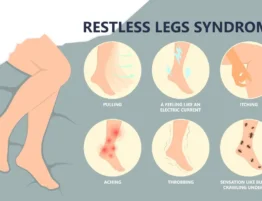
Idiopathic Neuropathy
Idiopathic neuropathy has similar symptoms to diabetic neuropathy. However, the word idiopathic means that there is no known cause. The sensory nerves can be affected, causing burning, numbness and tingling. Also, the motor nerves may be involved causing weakness oftentimes presenting as drop foot. The autonomic nervous system may also be affected causing cold feet that may look discolored. The symptoms generally are in the feet but may extend up to leg as far as the knee. Both legs and feet can be involved but for others it may only present on one foot or leg. Idiopathic peripheral neuropathy also is more prevalent in the senior population.
Symptoms of Neuropathy
Neuropathy symptoms can vary widely depending on which nerves are affected. Sensory nerves, responsible for sensation, may cause burning, numbness, and tingling, making it difficult to feel changes in temperature or pressure. This can lead to discomfort or even a loss of sensation, which is often most noticeable in the feet and legs.
In some cases, motor nerves are involved, which control muscle movement, potentially resulting in weakness and mobility issues like foot drop—a condition where lifting the front part of the foot becomes challenging. Additionally, when the autonomic nervous system is affected, individuals may experience cold, discolored feet due to poor blood flow. Symptoms typically begin in the feet but can travel up the leg, reaching as far as the knee. Neuropathy can manifest in both legs and feet or may be isolated to one side of the body.
Causes of Neuropathy
While diabetic neuropathy is a well-known type, neuropathy can result from various underlying conditions.
- Diabetes is the most common cause, but other factors can include alcoholism, infections, exposure to toxins, vitamin deficiencies, and side effects of chemotherapy.
- Additionally, autoimmune disorders, kidney disease, and genetic predispositions can lead to nerve damage. Idiopathic neuropathy refers to neuropathy with no identifiable cause, though it shares symptoms similar to diabetic neuropathy.
- For older adults, age-related changes and other health conditions may increase the risk. Determining the exact cause of neuropathy is crucial, as it guides the most effective treatment approach and helps alleviate symptoms.
How is it Diagnosed?
The symptoms that you communicate to your doctor helps the doctor diagnosis this condition. There may be other medical conditions such as diabetes, alcoholism, or cancer treatments that can all cause nerve damage. When these other factors have been eliminated as a cause then you may be told you have idopathic neuropathy. Evaluation and testing may include EMG and nerve conduction studies. Others may also take a biopsy of the skin to measure how many nerve endings under the skin or dying. This is called nerve density testing.
Treatments for Idiopathic Neuropathy
Traditionally treatments have involved the following
- Medications– anticonvulsants drugs such as Gabapentin and Neurontin are frequently used. They do nothing to improve the conditions of the nerves but can help with the symptoms.
- Lifestyle changes– avoiding carbohydrates and sugars may help along with getting regular exercise and plenty of sleep. Special shoes, or walking aids such as a can may also be suggested.
- Physical therapy– If weakness or numbness is present physical therapy may be helpful to decrease themchance of a fall.
Risks to your general health- When the symptoms become more severe the lack of feeling, pain and weakness can have a negative effect on your mobility. This reduction of activity can lead to weight gain and less physical fitness. In the senior population the risk of a fall and a broken hip may also increase.
How Idiopathic Peripheral Neuropathy may be Reversible?
In general, many healthcare providers are poorly trained in the treatment and evaluation of the peripheral nervous system. As a board-certified peripheral nerve surgeon we look at the nerves in the foot and leg differently. For many there may be compression of nerve tunnels in the foot or leg, much like carpel tunnel syndrome in the hand that can allow us to open, decompress, these tight nerve tunnels.
Therefore, what was once thought to be idiopathic neuropathy (of unknown cause), could be nerve compression. This provides hope for many, listen to Judy’s path to relief as she was afflicted with debilitating nerve pain.
Conservative Treatment Options for Idiopathic Peripheral Neuropathy
As a conservative option to surgery, we also offer ESTIM (electrical stimulation) and laser treatments which may also be very effective at reversing symptoms.
It’s important if you suffer from idiopathic neuropathy to learn more about this new way of looking at your nervous system and decide for yourself.
Neuropathy Symptoms of Weakness and Numbness Gone with ESTIM. Listen to Leslie’s Story !
View all our patient testimonials and webinars on ESTIM
Dr. James Anderson is a board certified surgeon with various publications on nerve compression. When considering a local podiatrist near you, review our results from patients and how our state of the art surgical center in Fort Collins, Colorado provides multiple benefits.

Please consider visiting the AENS website to look for a doctor in your area.
It’s important that you see a doctor trained in peripheral nerve surgery.









Write a comment: